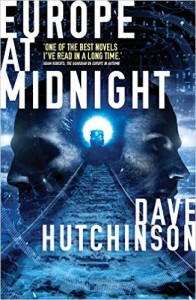 The reference that gets used most often to describe Dave Hutchinson’s Europe in Autumn is John le Carre. Now the sequel, Europe At Midnight has arrived and the comparison is even more apt. Like le Carre, Hutchinson excels at telling stories of espionage through quiet, human moments, only later revealing how those seemingly innocuous passages affected the larger whole. And like le Carre, Hutchinson punctuates his narratives with moments of unexpected violence that are all the more shocking because they feel so unlikely.
The reference that gets used most often to describe Dave Hutchinson’s Europe in Autumn is John le Carre. Now the sequel, Europe At Midnight has arrived and the comparison is even more apt. Like le Carre, Hutchinson excels at telling stories of espionage through quiet, human moments, only later revealing how those seemingly innocuous passages affected the larger whole. And like le Carre, Hutchinson punctuates his narratives with moments of unexpected violence that are all the more shocking because they feel so unlikely.
Which is, of course, a roundabout way of saying that Europe At Midnight is very good indeed, both as a mannered novel of espionage and as an incisive critique of the forces at play behind the spies and secret agents. The book’s opener takes a bold risk, putting the reader in a setting that seemingly has nothing to do with any of the events of the previous volume – a post-revolt university called The Campus where the surviving faculty and students are struggling both politically and for simple survival. The reader’s doorway into this world is Richard, or as he calls himself in a nod to the Prisoner of Zenda, Rupert of Hertzau, who functions as the head of Intelligence for the reeling, starving Campus. Chasing down the misdeeds of the murderous Old Board, he stumbles onto a path that literally takes him out of his world and into ours, one where no one has ever heard of The Campus and he’s lost and alone.
Except in our world there’s an intelligence operative named, quaintly enough, Jim, whose investigation of a random act of commuter violence quickly leads him to something deeper and stranger – the existence of a parallel country called Ernshire created, or perhaps accessed, by an eccentric English family called the Whitton-Whytes. For some reason, the existence of a nation that can access Hutchinson’s fractured Europe at any point makes certain people in the corridors of power a little nervous, and when extra-dimensional traveler Rupert comes along, they send Jim to find out what he knows.
What follows is a low key, quietly cutting assessment of a fracturing Europe, and a devastating critique of a what a purely English space without any European influence might be. It’s also a savage look at what drives the national security apparatus, as the purely investigative unit Jim is initially assigned to is slowly subsumed by forces more interested in new markets than new worlds, and the people responsible for doing the hard work are inevitably sidelined and destroyed.
What Europe At Midnight is not, however, is a direct sequel to the first book in the sequence, at least not as one might be expecting. While the mysterious Couriers still play a part, and the notion of parallel worlds remains, there’s no sign of Rudi, the protagonist of the first book. It’s the same setting, but from a different angle and with a different cast, the better to show off different perspectives on the thorny issues the books are tackling.
But perhaps the best way to read Europe At Midnight is as satire. The Europe Hutchinson describes is fractured and Balkanized, devastated by a flu pandemic and dotted here and there with elements of science fiction technology. But it’s also recognizably a version of our world – there’s still homeless shelters with shared computers and marriages that crumble under job pressure – where certain elements are amped up just enough to be seen as targets of ridicule. The walled city-state of Dresden is presented as an impregnable island in the sea of European turmoil, a rich data haven that wants no part of its neighbors. It’s also presented as a bunch of gated community nouveau riche types who can’t figure out that building skyscrapers on top of frail sewers is a bad idea, and who are too in love with progress to stop (and too in love with keeping the riff-raff out to ask for any sort of reasonable help). As for Ernshire, that perfect slice of uncontaminated Britannia left to its own devices for a century, it’s doughy and bland and dangerous all at once, a place so boring that fast food burgers are a flavor explosion for those who escape and so self-absorbed it will cheerfully set up pocket universes for “self defense” research and then nuke them out of existence when they become awkward. The only heroes here are the little people, the individuals willing to do what they can in the face of brutality and loss for others, and even then they know their efforts are ultimately limited.
Ultimately, Europe At Midnight is a reader’s spy novel, gently tucking its big and scary ideas behind seemingly small-scale narrative moments. Those looking for explosions and stunts can find them plenty of other places. What this book offers are more understated, and ultimately more enduring delights.
(Solaris, 2015)
